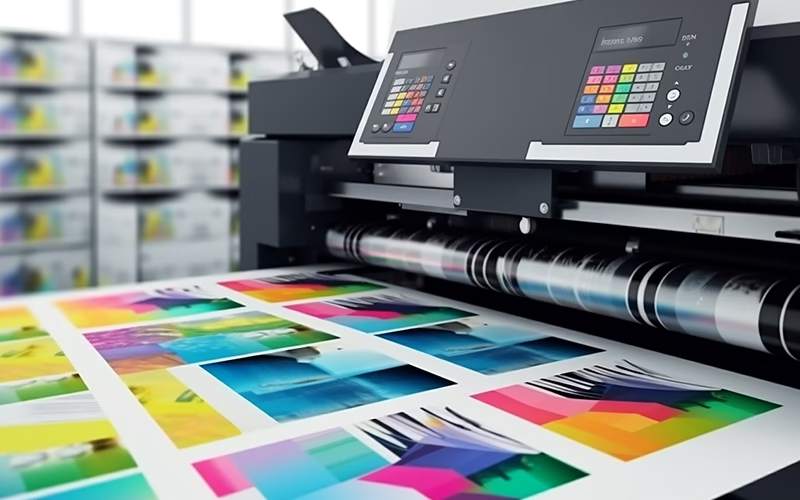As a graphic designer passionate about quality and detail, I know how frustrating it can be to see a spectacular design lose its magic when printed with the wrong equipment. For years, I’ve experimented with different printers and learned that the difference between a standard printer and a professional one can be enormous when it comes to faithfully reproducing our designs.
In this guide, I’ll share with you my in-depth analysis of the three best printers specifically selected for graphic design. I won’t just talk about technical specifications (which are crucial), but I’ll also share my real-world experience with each one. My goal is to help you find the printer that not only meets your expectations but exceeds them.
Choosing a professional printer isn’t just about resolution or speed. It’s about finding the perfect balance between print quality, material versatility, precise color management, and, of course, operating costs. A good printer isn’t an expense: it’s an investment that can open up new opportunities for your creative business.
Key Aspects to Consider
Printing Technology
The choice between inkjet or laser is crucial:
Inkjet: Ideal for photography and designs with gradients
Laser: Perfect for crisp text and vector graphics
Sublimation: Excellent for merchandising and textiles
Ink System
- Number of cartridges (minimum 8 for professional reproduction)
- Ink types (pigmented vs. dye-based)
- Cartridge size
- Cost per page
- Print durability
Color Accuracy
Fundamental aspects for chromatic fidelity:
- Color management capabilities
- Built-in ICC profiles
- Calibration and consistency
- Wide color gamut
- Compatibility with design software
Resolution and Print Quality
- Native resolution (minimum 2400 x 1200 dpi)
- Variable drop size
- Gradient quality
- Sharpness in small text
- Uniformity in solid areas
Material Versatility
The ability to work with different media:
- Supported paper weights
- Paper types (matte, glossy, fine art)
- Maximum sizes
- Borderless printing
- Special feed for thick paper
Connectivity and Workflow
Essential options for efficient work:
- Wi-Fi and Ethernet
- Direct printing from USB
- Mobile device compatibility
- Included management software
- Automatic calibration
Operating Costs
Factors affecting the long-term budget:
- Consumable prices
- Cartridge yield
- Cost per page
- Maintenance kits
- Warranty and technical support
Speed and Productivity
Aspects affecting workflow:
- First print time
- Speed at different qualities
- Tray capacity
- Drying time
- Automatic cleaning system
The 3 Best Printers for Graphic Design
1. Canon image PROGRAF PRO-1000
Key Features
- 12-ink LUCIA PRO system
- Up to 4800 x 2400 dpi resolution
- Maximum A2 size
- Automatic color calibration
- Inkjet nozzle clogging prevention system
Advantages
- Exceptional print quality
- Deep blacks and vibrant colors
- Excellent detail reproduction
- Automatic calibration process
- Included professional software
Disadvantages
- High price
- Expensive consumables
- Considerable size and weight
Approximate Price: €1,299
2. Epson SureColor P900
Key Features
- 10-ink UltraChrome PRO10 system
- Up to 5760 x 1440 dpi resolution
- Maximum A2+ size
- 4.3 touch screen
- Fine art paper compatible
Advantages
- Compact design for its category
- Excellent black and white reproduction
- Automatic paper changing
- Wi-Fi and direct mobile connection
- Lower cost per print
Disadvantages
- Smaller cartridge capacity
- Steep learning curve
- No continuous ink refill
Approximate Price: €1,199
3. HP DesignJet Studio 24
Key Features
- 4-ink HP Bright Office system
- Up to 2400 x 1200 dpi resolution
- Up to 24-inch wide printing
- Integrated cloud connection
- Minimalist and modern design
Advantages
- Excellent connectivity
- Cloud-based direct printing
- Stylish and compact design
- Easy setup and use
- Good operating costs
Disadvantages
- Fewer ink colors
- Not the best for photography
- Less precise color quality
Approximate Price: €999
Find the Printer That Will Elevate Your Designs
After a detailed analysis of these three professional printers, I want to share my final thoughts to help you choose the one that best suits your specific needs.
Recommendations Based on Your Profile
For Professional Design Studios
The Canon image PROGRAF PRO-1000 is your best ally. Its 12-ink system and automatic calibration guarantee exceptional color reproduction. Yes, the initial investment is high, but the quality and consistency it offers make it an essential tool for demanding work.
For Established Freelance Designers
The Epson SureColor P900 is your ideal option. It combines excellent print quality with material versatility. Its more compact size makes it perfect for small studios, while its ink system delivers consistent professional results.
For Growing Studios
The HP DesignJet Studio 24 offers an excellent entry point into the world of professional printing. Its advanced connectivity and ease of use make it perfect for teams that need fast and reliable results, although it sacrifices some color accuracy.
My final advice: consider the printer as a long-term investment. Initial costs may seem high, but a good professional printer:
- Reduces outsourcing costs
- Allows greater control over the final quality
- Offers flexibility in delivery times
- Opens up new business opportunities
Remember: the perfect printers for graphic design is one that not only meets your current needs but also has the potential to grow with your business.

